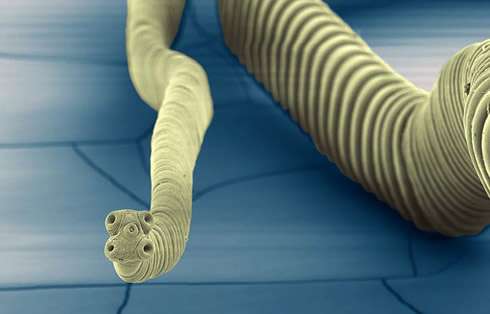First tapeworm genomes give insights into parasite evolution

Tapeworms have no gut or head. They are parasites that cause debilitating diseases, which can be deadly and often don't respond to drugs. Now, scientists have mapped the genetic code of tapeworms for the first time, the journal Nature reports.
Tapeworms are one of the oldest groups of parasites known and cause 2 of the World Health Organisation's 17 neglected tropical diseases. The adults can live harmlessly in the gut and are readily treated. However, infection with tapeworm larvae results in cysts in the organs, tissues and central nervous system, of humans and animals. These can cause complications such as blindness and epilepsy, or even death.
Full genomes of 4 tapeworms
An international team of scientists led by the Sanger Institute and including those at the Natural History Museum sequenced the full genetic code, or genome, of 4 tapeworm species including the identification and cataloguing (characterising) their around 11,000 genes.
As well as giving insights into the evolution of parasitism, the tapeworm genome research also identified a list of candidate genes to target drugs at and provides an enormous resource for both basic and applied research, the team says.
Losing genes
The results reveal clues about how these parasites function and develop, and how their genetics have changed over time.
For example, as parasitism evolved in the ancestor of these animals, many genes were lost, such as those necessary to synthesise fats and cholesterol that are crucial for development. Tapeworms thus must scavenge and modify these from their host's diet.
Knowledge about the genes involved could help scientists use drugs to disrupt this process and potentially provide an effective treatment.
Another major genetic loss that was identified was a large group of genes important in patterning the body during development, called homeobox genes - the largest loss of this class of genes yet seen in the animal kingdom, the team says.
Same basic genes
In contrast, the genome results showed that many of the basic genes and genetic pathways involved in cellular regulation and communication found in free-living animals, including humans, remain present in tapeworms.
Cancer similarities
The team discovered that many of the tapeworm disease processes are similar to those of cancer tumours, and their list of candidate drug targets showed many of the same genes targeted by pre-existing cancer chemotherapies, suggesting that tapeworms could be susceptible to such treatments.
Unique opportunity
Museum biologist Dr Peter Olson, who was part of the research team, says, 'The availability of the 4 tapeworm genomes herald not only a plethora of inroads for the treatment and control of tapeworm infection, but also offer a unique opportunity to understand how the evolution of a parasitic lifestyle affects the genome.
'Although a large number of genomes have now been characterised, these are among the first for animals living an obligately parasitic lifestyle, and thus allow us to address many long-standing questions about the nature of parasitism, arguably the most common form of life on the planet.'
More information: Nature paper: "The genomes of four tapeworm species reveal adaptations to parasitism"
Journal information: Nature
Provided by Natural History Museum
















